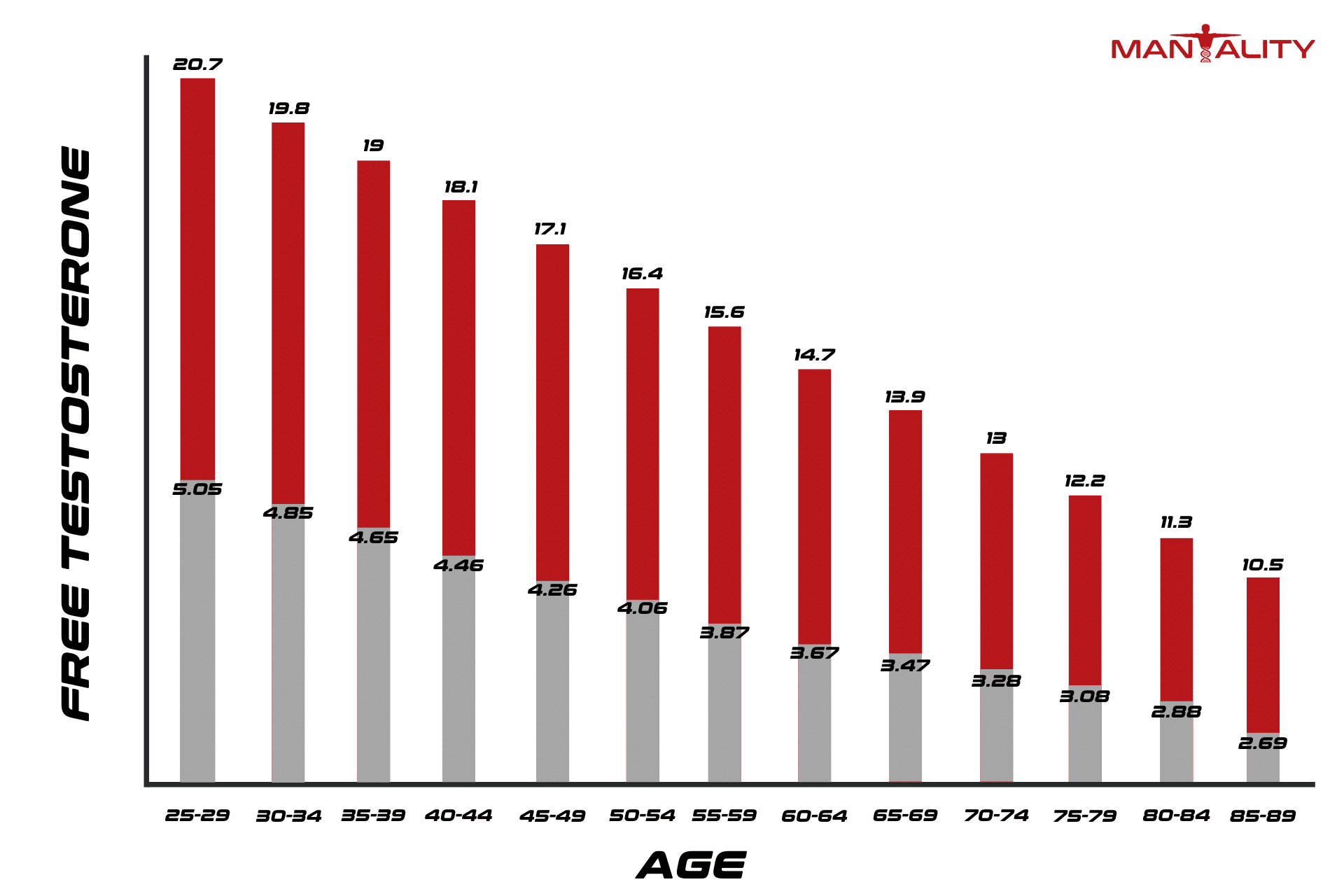While men naturally lose testosterone as they age, it’s crucial to maintain healthy T levels throughout life. But according to the American Urology Association, two out of every 100 men suffer from low testosterone production.
Physical activity provides plenty of full-body benefits. Exercise supports healthy weight and improves sleep quality. Working out decreases our risk of cardiovascular disease and cancer. Regular fitness routines keep our mental health in check by lowering stress levels.
But does exercising increase testosterone? Let’s explore the effects of testosterone and exercise on your health.
How Does Testosterone Affect Your Health?
Before we explore the link between testosterone and exercise, let’s review the essential role testosterone plays in men’s health.
Testosterone is your body’s sex hormone. While men have higher amounts, every human has some levels of testosterone in their bodies. Testosterone is produced by the adrenal glands. In men, the majority of the testosterone production occurs in the testicles.
When testosterone levels increase during puberty, men experience bodily changes. This includes muscle gain, facial and pubic hair growth, and a lowered voice. Normal testosterone levels range between 300 and 1,000 nanograms per deciliter.
Healthy testosterone levels are crucial for men. Low testosterone is diagnosed when the hormone drops below 300 nanograms per deciliter. If you suspect your hormone levels are low, a blood test can determine your circulating testosterone.
Low levels of the hormone are unhealthy and decrease the quality of life for men. Low testosterone:
- Reduces hair production
- Diminishes sex drive
- Causes fatigue and irritability
- Leads to low muscle mass, a decrease in bone mass, and an increase in body fat
- Deflates blood counts and raises your risk of anemia
- Hinders brain function and increases your risk of cognitive disorders
Fortunately, there are natural ways to raise testosterone levels. One of the most natural testosterone enhancers is exercise.
Does Exercising Increase Testosterone?
Medical professionals believe exercise produces full-body benefits, including naturally raising testosterone levels.
In 2012, researchers concluded physically active men showed better hormone production levels compared to men who led sedentary lifestyles.
Other research findings have observed:
- Weight lifting increases testosterone in men
- Higher growth and testosterone hormone levels exist in men who regularly exercise
- Increased T levels in obese men after working out
How does working out increase testosterone? There are a few different ways physical activity stimulates T production.
1. Your Weight and Testosterone Levels
Obesity is linked to lowered T levels. Researchers have conducted numerous studies that show how weight gain leads to impaired health and decreased hormone productions.
Exercise not only sheds pounds, but it kickstarts your body’s natural reactions. It gets the heart pumping to increases blood flow and circulation. In doing so, physical activity decreases bad hormones, like cortisol, and increases the production of essential hormones, like testosterone.
Exercising also has positive effects on medical ailments that impact testosterone levels, like type 2 diabetes. One in six men living with type 2 diabetes also has low testosterone levels. Regular exercise helps you maintain a healthy weight and minimizes your chance of developing diabetes.
Exercise can also ease the symptoms of low testosterone in men. Physical activity helps you sleep better, which lessens daytime fatigue. Mood swings are common in men with low T, but exercise can help. It enhances your mood, reduces stress, and clears up brain fog.
Exercising allows you to naturally shed pounds, which results in full-body benefits, like improved T levels.
2. Your Age and Testosterone Levels
As you get older, testosterone levels naturally drop. After 30, most men experience a slow decline in their hormones. While it’s natural for T levels to dwindle, exercise stimulates production, so your body can maintain a healthy level of testosterone.
Exercise can boost testosterone levels in any man, no matter the age. Exercise helps men maintain strong bone mass, increase endurance, enhance cognitive functions, and maintain healthy circulation.
Older men may not observe as intense spikes of testosterone after working out compared to younger men. But sticking to a regular exercise routine enhances bodily functions, like T production, and improves the quality of life.
3. Your Exercise Routine and Testosterone Levels
How often you work out plays a key role in increasing testosterone. One trip to the gym will feel good, but it won’t be enough to generate higher T levels.
Researchers have noted that men who stick to a regular fitness routine experience the greatest benefits. To enhance hormone production, men should exercise three to five days per week.
The time you work out also plays a role in testosterone production. T levels vary during the day. Male testosterone production is highest in the morning and lowest in the afternoon. Therefore, morning workouts are better for boosting your T levels.
4. Your Fitness Levels and Testosterone Levels
If you’re just getting started on a regular exercise routine, you will notice a bigger increase in T levels compared to men who are already in decent shape.
When you begin working out, your body has a positive reaction. You may notice fast weight loss, notable mood changes, and higher testosterone levels.
But as you continue exercising, your body gets used to the routine. If you’re not careful, the positive effects of working out can plateau.
Switching up your workouts creates muscle confusion and challenges your body. Different routines and workouts enhance fitness levels and help your body maintain high testosterone production.
Exercises That Increase Testosterone
Joining a gym or fitness club is a great way to ensure you stick with your exercise routine. But if you’re limited, there are plenty of home exercises to increase testosterone.
Researchers have found the most effective exercises for improving T levels are weight training and HIIT workouts.
Weight Training
Resistance training and weight lifting boost testosterone. Strength exercises focus on building strong muscles. As muscle mass increases, so does testosterone production.
Strength training should hit all of your muscle groups. It’s easy to remember to work out your back, chest, and quads. But don’t forget the little guys, like your biceps, shoulders, and calves.
Weight training is the movement of any weight against resistance. Any type of exercise that pushes your muscles to perform outside their comfort zone ignited changes. As you build muscle mass, gradually increase your weight selections. Your muscles will be forced to adapt, rebuild, and become stronger.
In weight lifting, maintaining a correct form is critical. Many people get hurt because they attempt to lift too much weight for their body or do not use the proper form. If you’re new to resistance training, ask for help from a trainer to ensure you don’t get injured.
Weight training helps you build a stronger body. In addition to stimulating T production, strength exercises also enhance your balance, increase your metabolism, and help shed those extra pounds.
High-Intensity Interval Training (HIIT)
High-intensity interval training involves short bursts of intense exercise followed by a low-impact recovery. HIIT training improves peak power outputs. The training mixes aerobic and resistance training, giving your body an excellent workout.
HIIT intervals are fast and furious. A person’s heart rate reaches 80% or more of its maximum capacity. The intervals can last from one to five minutes.
High-intensity training boosts cardio-respiratory health. It improves your metabolic rate. HIIT training is so effective because it keeps burning calories hours after the exercise has been completed.
Anything that spikes your heart rate and gets your blood pumping can be turned into a HIIT workout. High-intensity training includes fast intervals of sprints, burpees, jumping jacks, tuck jumps, and jumping rope.
To determine the link between HIIT and testosterone levels, researchers replaced normal aerobic training with HITT training. The male participants showed increased free-T production and muscle power.
In another study, 18 road cyclists were split into two groups. The group who underwent high-intensity training reported a 97% increase in T levels after four weeks of training.
The effects of HIIT and testosterone vary by gender. Researchers have also observed that while HIIT training is great for T production in men, it may lower testosterone production in women.
What Exercises Lower Testosterone?
There are excellent workouts that increase testosterone. But can exercise lower testosterone? Unfortunately, certain workouts lead to decreased testosterone production.
Chronic endurance is not ideal for men looking to up their T levels. Long cardio workouts such as lengthy cycling rides or runs decrease testosterone.
High-endurance athletes have higher levels of cortisol, which diminishes T production. Higher cortisol levels also negatively impact your mood, sleep, and muscle mass.
The best way to get the benefits of cardio without the side effects is by breaking up your workouts.
Instead of a two-hour trail run, run for 30 minutes five days a week. Rather than cycling for hours, take 30-minute spinning classes throughout the week. Your body will maintain its endurance while stimulating healthy T levels.
How Can I Get Into a Workout Routine?
Exercise is beneficial for testosterone production. The problem for many men, however, is sticking to a solid regiment. What’s the best way to get into a new workout routine?
First, get into the right attitude. Don’t motivate yourself by thinking you’re fat, lazy, or unattractive. Instead, trade the negative thoughts for positive ones.
Remind yourself how working out can enhance your health. Regular exercise stimulates testosterone production. Physical fitness is crucial for maintaining a healthy weight. Working out enhances respiratory, heart, and mental health.
With these benefits in mind, you should feel motivated to hit the gym.
To stick with your exercise routine, avoid burning out. A whopping 90% of people quit after 3 months of hitting the gym. It’s good to go hard, but exhaustion and injuries make sticking to workout regiment difficult.
Pace yourself and gradually improve upon your workouts. Start by exercising three days per week. When you’re ready, add another day. Keep this up until you’re working out five days a week.
Finally, don’t forget to rest. Two rest days per week are ideal. The downtime gives your muscles a chance to recover, lowers your risk of injuries, and helps you go hard during your workout days.
By keeping up with a healthy exercise regiment, you’ll notice full-body benefits. This includes a boost in T production, less stress, improved moods, and enhanced sleep quality.
Are There More Ways to Naturally Enhance Testosterone Levels?
While exercising increases testosterone, there are other methods that naturally boost T levels. You can naturally stimulate testosterone by:
- Eating testosterone-boosting foods
- Managing cortisol levels
- Getting enough vitamin D
- Receiving proper rest
- Undergoing hormone replacement therapies
In terms of diet, shellfish with high zinc levels like oysters, crab, and shrimp do wonders for testosterone. Nutrient-rich cruciferous vegetables push out excess estrogen and help T levels soar. Try to incorporate veggies like broccoli, cauliflower, and cabbage into your diet. Other testosterone-boosting foods include garlic, beans, and tuna.
Exercise enables T production by lowering cortisol levels. Aside from physical activity, you can reduce stress by practicing meditation, deep breathing, and treating yourself to a hot bath. Lower cortisol levels also help you sleep better at night, which is another way to naturally stimulate T production.
Low testosterone hormone replacement treatments naturally stimulate free T production in men. The therapy helps men regain hormonal balance, so they feel stronger. It reduces common symptoms of low T, such as fatigue and irritability.
Start Increasing Your Testosterone
Healthy T levels are imperative for men. When hormone levels drop, men experience severe side effects that diminish their quality of life.
Does exercising increase testosterone? It sure does. Regular workouts, like weight and HIIT training, allow men to naturally stimulate T production.
There are other ways to enhance testosterone levels in men, aside from exercise. Testosterone Replacement Therapy (TRT) is safe and lab-tested. Our treatments help men of all ages increase their levels of free testosterone and live healthy lives.
For more information on our testosterone treatments and services, contact our team.




